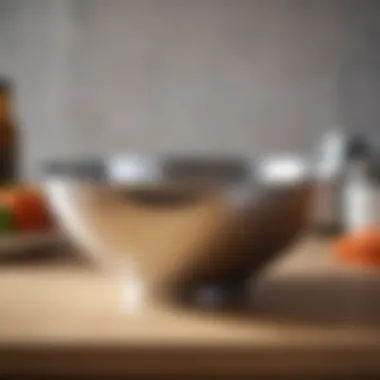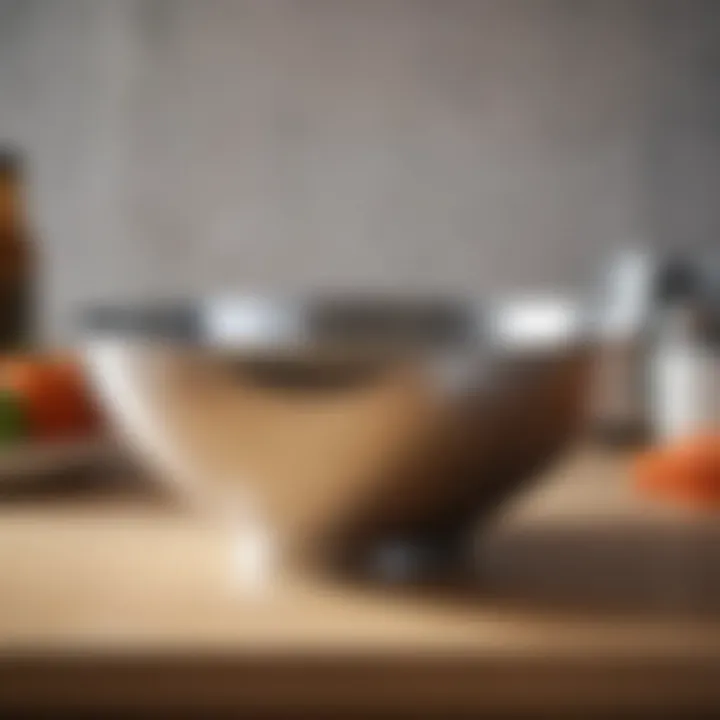Exploring Deep Stainless Steel Mixing Bowls


Intro
Deep stainless steel mixing bowls represent a fundamental tool in many kitchens. They are favored not only for their aesthetic appeal but also for their utility and durability. With a wide range of sizes and depths available, these bowls can handle various tasks, from mixing dry ingredients to preparing delicate sauces.
The versatility of these bowls allows them to serve multiple purposes. They can be used for marinating, washing vegetables, or even as a double boiler in some cooking techniques. Many home cooks appreciate how deep stainless steel mixing bowls enhance their culinary experience and streamline their food preparation process.
Moreover, the material itself offers several advantages. Stainless steel is non-reactive, which means it does not alter the flavor of food. Additionally, the surface is easy to clean and resistant to staining and odors. This makes it an optimal choice for both casual cooks and culinary enthusiasts alike. As we explore the nuances of deep stainless steel mixing bowls, readers will gain insights into their benefits, maintenance tips, and how they compare to other materials used in kitchenware.
Understanding Deep Stainless Steel Mixing Bowls
Deep stainless steel mixing bowls are essential tools in many kitchens. They offer a combination of durability, versatility, and practicality. This section dives into what defines these mixing bowls and how they serve various purposes in culinary settings. Understanding their features allows both novice cooks and experienced chefs to make informed choices, enhancing efficiency in food preparation.
Definition and Purpose
Deep stainless steel mixing bowls are specifically designed to facilitate a wide range of cooking tasks. Often characterized by their tall sides and broad base, these bowls are built to hold larger quantities of ingredients while minimizing splatter. The stainless steel material adds another layer of functionality. It is resistant to rust, easy to clean, and can withstand the rigors of frequent use. As a result, these bowls serve both practical and aesthetic purposes in the kitchen.
Common Uses in the Kitchen
The versatility of deep stainless steel mixing bowls makes them indispensable. Here are some common uses:
- Mixing Ingredients: Whether for salads or batters, these bowls provide enough space for thorough mixing without ingredients spilling over.
- Marinating Foods: Their depth enables ingredients to be fully submerged in marinades, promoting flavor infusion.
- Serving Dishes: With their sleek appearance, they can transition from mixing bowl to serving dish effortlessly.
- Storing Ingredients: Covered with plastic wraps, they can store prepped ingredients in the fridge, maintaining freshness.
These bowls play a critical role in cooking processes, supporting everything from simple tasks to more complex recipes. Home cooks can rely on them for consistent results.
Material Composition and Benefits
Understanding the material composition of deep stainless steel mixing bowls is essential for recognizing their value in culinary practices. These bowls are not only functional but also durable and versatile. Their construction dictates their performance in various cooking environments, and insights into their benefits can guide consumers in making smart choices for their kitchens.
Properties of Stainless Steel
Stainless steel is a composite material known for its notably high resistance to corrosion and rust. This enhances its longevity in the kitchen. Bowls made from stainless steel can withstand heat better than other materials, making them suitable for mixing ingredients that may generate warmth, such as dough. Furthermore, they do not retain odors or stains, ensuring a clean and hygienic surface for food preparation.
A key aspect is its non-reactive nature. This characteristic is significant when working with acidic ingredients like tomatoes or vinegar, as it prevents alterations in flavor or color. In addition, stainless steel bowls are lightweight. This feature aids in ease of handling during both preparation and mixing tasks.
Comparison With Other Materials
Glass
Glass mixing bowls are often favored due to their aesthetic appeal. They provide a clear view of contents, which can reduce the likelihood of spills or oversights during preparation. Glass is also non-porous, which means it does not absorb stains or odors like plastic might. However, their fragility poses a disadvantage. Shattering can occur if dropped, which may cause safety hazards in the kitchen. Glass bowls can also heat unevenly which may impact sensitive mixtures.
Plastic
Plastic bowls are lightweight and inexpensive, appealing to budget-conscious consumers. They often come in various colors and designs, adding an element of personalization to kitchenware. However, plastic has its drawbacks. It tends to retain odors and stains after prolonged use, possibly influencing the flavors of future preparations. Some plastic types may warp under high temperatures, limiting their versatility.
Ceramic
Ceramic bowls possess a classic, appealing look, often available in vibrant colors and patterns. They are heavier than stainless steel and do not slide easily on countertops, providing stability while mixing. However, their brittleness is a concern. A dropped ceramic bowl is likely to break, presenting safety issues. Furthermore, while they can be non-reactive, certain ceramic coatings may not withstand high heat or acidic materials, impacting their utility in the kitchen.
Understanding the material properties is crucial to selecting the right mixing bowls for specific culinary applications.
Design Features of Deep Mixing Bowls
The design features of deep stainless steel mixing bowls significantly influence their utility and performance in various culinary tasks. Their distinct depths and shapes cater to specific cooking requirements, ensuring optimal functioning during food preparation. By understanding these design elements, users can make informed choices on what best suits their needs in the kitchen.
Depth and Shape Considerations
The depth of mixing bowls is an important design attribute. Deep mixing bowls prevent ingredients from spilling over during vigorous mixing or beating. This characteristic is especially beneficial when handling larger quantities or when rigorous techniques such as whisking or beating are used. Furthermore, deep bowls can also accommodate larger tools, like electric mixers, without risk of damage to either the bowl or the appliance. The shape of the bowl can also affect how ingredients mix. A more rounded profile allows for thorough blending while minimizing pockets where ingredients can be trapped.
Size Variations
The size of mixing bowls plays an essential role in their functionality. Deep stainless steel mixing bowls come in various sizes, each catering to specific tasks in the culinary spectrum.
Small
Small mixing bowls are ideal for tasks that require modest quantities of ingredients. They are beneficial for mixing small amounts of spices, dressings, or sauces. Their compact size means they are easy to handle and store, making them a popular choice for individual servings or smaller recipes. However, for larger batches, their size can be a limitation, requiring multiple bowls to accommodate the volume needed.
Medium
Medium bowls strike a balance between utility and space. They are versatile and can be used for many general mixing tasks, such as preparing cake batter or salad. Their size allows for a comfortable amount of space to mix without risk of spillage while remaining easy to handle. Additionally, they are often used for marinating meats or mixing dough, making them a staple in many kitchens. The downside may arise when attempting to use them for large batches, thus limiting their application in larger tasks.
Large


Large mixing bowls provide ample space for preparing significant quantities of food. They are advantageous for recipes that require large blending, like mixing large batches of dough or salads for gatherings. The larger size allows for easy incorporation of ingredients without the risk of overflow. Nonetheless, these bowls can be cumbersome to handle and may take up substantial storage space, which can be a significant consideration for those with limited kitchen room.
Overall, choosing the right size deep stainless steel mixing bowl can enhance efficiency in preparing various dishes while avoiding frustration and mess.
Functional Advantages in Cooking
Deep stainless steel mixing bowls offer numerous functional advantages that can transform the culinary experience. Their design and material properties enable various cooking tasks, making them essential tools in kitchens of all types. The functionality and convenience these bowls provide enhance both performance and efficiency in food preparation, serving, and marinating.
Versatility in Food Preparation
Mixing
Mixing is a fundamental aspect of cooking. Deep stainless steel mixing bowls excel in this area due to their sturdy construction and smooth interior. This allows for thorough mixing without the risk of ingredients clinging to the sides, ensuring even incorporation. These bowls have a wide brim, making it easy to mix large batches of dough or batter without spillage. The weight of stainless steel also keeps the bowl stable on the countertop, making it a popular choice for pastry chefs and home bakers alike. However, their reflective surface can sometimes lead to confusion in gauging ingredient colors, so careful observation is necessary while mixing.
Marinating
Marinating meats and vegetables is crucial for enhancing flavor. Deep stainless steel mixing bowls are perfect for this task. Their non-reactive surface ensures that acidic marinades do not interact unfavorably with the bowl material. This characteristic is particularly important when working with vinegar or citrus-based marinades. The depth of these bowls allows for better immersion, ensuring all parts of the food are coated evenly. A disadvantage to consider is that, without a proper lid, marinating can sometimes expose food to air and contaminants, which can affect flavors.
Serving
Serving directly from a deep stainless steel bowl adds a touch of simplicity to meal presentation. Its sleek design enhances the visual appeal when serving salads, pasta, or snacks. The heat retention properties of stainless steel mean that food can stay warm for a longer period, making it advantageous for serving hot dishes. However, care must be taken when serving cold items, as the bowl can sometimes conduct heat from the hands, making it uncomfortable to hold for extended periods.
Heat Retention and Conductivity
Deep stainless steel mixing bowls possess excellent heat conductiviity and retention properties. This means they can maintain the temperature of warm foods longer than many other materials. When mixing hot ingredients, the steel does not warp or break, which can be a concern with glass or ceramic. Conversely, this property also means that when food is at room temperature, the bowl can feel cool to the touch, making it effective for tasks needing precise temperature management.
In summary, the functional advantages of deep stainless steel mixing bowls in cooking are numerous. Their versatility for mixing, marinating, and serving enriches the cooking experience. Understanding these advantages helps home cooks make informed choices, ensuring a more enjoyable and efficient time in the kitchen.
Maintenance and Care
The longevity and performance of deep stainless steel mixing bowls rely heavily on proper maintenance and care. Understanding how to keep these bowls in optimal condition enhances their utility in the kitchen and contributes to a healthier culinary practice. By implementing appropriate upkeep methods, users can enjoy their mixing bowls for years, thus ensuring a sound investment.
Cleaning Techniques
Cleaning stainless steel mixing bowls requires attention to detail to prevent any lasting residues or stains. This material does not harbor bacteria, making it a preferred choice for food preparation.
To effectively clean deep stainless steel mixing bowls, one should follow these steps:
- Immediate Rinse: After use, rinsing the bowls with warm water can help remove food particles before they dry.
- Dish Soap: A mixture of warm water and mild dish soap is often sufficient for most cleaning tasks. Use a soft sponge or cloth to scrub the surface gently.
- Baking Soda Solution: For tougher stains, a paste made of baking soda and water can be effective. Apply the paste, let it sit for a few minutes, then scrub gently before rinsing.
- Drying: It is important to dry the bowls immediately after washing to avoid water spots. A soft cloth works best for this task.
Avoiding Damage and Scratches
Deep stainless steel mixing bowls are durable; however, care should be taken to maintain their pristine condition. Scratches and dents can compromise their appearance and performance. To avoid damage, consider these practices:
- Use Appropriate Utensils: Opt for silicone or wooden utensils when mixing. Metal utensils can create scratches on the bowl's surface.
- Store Properly: Nesting bowls can save space, but separating them with a soft cloth or using bowl protectors can prevent scratching.
- Avoid Submerging in Hot Water: While they are heat resistant, submerging bowls in hot water for long periods can warp or damage their structural integrity. Stick to rinsing and washing at moderate temperatures.
Proper maintenance ensures your mixing bowls remain functional and visually appealing, enhancing your overall cooking experience.
With these basic maintenance and care techniques, deep stainless steel mixing bowls can serve their purpose efficiently, adapting to various cooking needs without losing their integrity.
Purchasing Considerations
When it comes to selecting deep stainless steel mixing bowls, purchasing considerations play a crucial role in ensuring one makes an informed decision. Its importance cannot be overstated, as the right choice can significantly enhance one’s cooking experience. Understanding the elements that contribute to quality, durability, and price can guide consumers towards the best option tailored to their needs.
Evaluating Quality and Durability
Quality and durability are fundamental factors when choosing deep stainless steel mixing bowls. Stainless steel is renowned for its robustness. It does not chip, crack, or stain like other materials, ensuring longevity. However, not all stainless steel is equal. Look for bowls made from high-grade stainless steel, such as 18/10 or 304 grade, which has higher chromium and nickel content, making it more resistant to corrosion and rust.
Another consideration is the gauge of the metal used. Thicker bowls generally offer better durability and heat retention. Pay attention to the finish as well; a polished surface can give a modern look but may scratch more easily than brushed finishes.
Price Points and Brand Comparison
Understanding the difference between high-end brands and budget options enables buyers to choose an option that fits their financial constraints and quality expectations.
High-End Brands
High-end brands such as All-Clad and Mauviel stand out in the market due to their impressive quality and craftsmanship. These brands typically focus on superior materials, ensuring their bowls last a lifetime. A key characteristic that sets them apart is the meticulous attention to detail in their manufacturing processes, which may include features like triple-layer construction for improved heat distribution.
One unique feature of high-end brands is the warranty they offer. Many of them provide extensive warranties reflecting their confidence in product durability. Although the initial investment is higher, many consider it worth it due to the durability and performance these bowls deliver in the kitchen.
Budget Options


Conversely, budget options such as Rubbermaid or OXO offer practical solutions without compromising too much on quality. These brands attract consumers looking for functional and accessible kitchen tools. A notable characteristic is their lightweight nature, which can be an advantage for those who prefer ease of handling during food preparation.
However, opting for budget options may come with some disadvantages. Often, these bowls may not last as long as their high-end counterparts, and they may lack advanced features, such as non-slip bases or heavy-gauge construction. This makes it important for consumers to weigh the trade-offs of cost savings against potential quality declines.
Innovations in Design
The world of culinary tools is constantly evolving. Among this evolution, deep stainless steel mixing bowls are experiencing significant innovations. These advancements not only enhance the functionality of the bowls but also improve the overall cooking experience for users. The importance of understanding these innovations lies in their ability to optimize kitchen tasks and provide long-term value.
Emerging Features
Recent trends show manufacturers incorporating various emerging features into deep mixing bowls. One notable innovation is the introduction of anti-slip bases. This design prevents bowls from sliding during vigorous mixing, enhancing user safety and comfort. Another trend involves bowls with interior measurements marked directly on the metal surface. This allows cooks to measure ingredients accurately without needing additional tools.
Convenience is also increasing with stackable designs. These modern bowls can easily nest within one another, optimizing storage space. Additionally, some manufacturers now offer mixing bowls with lid attachments. These lids make it easy to cover food for marinating or storing leftovers. Such innovations illustrate the evolving demands of home chefs for functionality, ease of use, and efficiency.
Sustainability in Manufacturing
A significant focus in the kitchenware industry is sustainability. Consumers are increasingly interested in the environmental impact of their purchases. This trend has led to innovations in how deep stainless steel mixing bowls are produced. Many manufacturers are now adopting sustainable practices in their sourcing and production processes. They prioritize recycled materials or eco-friendly production methods, which reduces the overall carbon footprint.
Using stainless steel itself is a sustainable choice. Stainless steel is durable, which extends the lifespan of the product, reducing the need for frequent replacements. Moreover, it is fully recyclable, offering a beneficial option for environmentally conscious consumers. When selecting mixing bowls, it is worth considering brands that emphasize sustainability in their production. This not only meets personal culinary needs but also contributes positively to the environment.
"Incorporating sustainable practices in kitchenware manufacturing reflects a growing consumer awareness about environmental issues."
The combination of innovative features and an emphasis on sustainability ensures that deep stainless steel mixing bowls not only meet current culinary demands but do so responsibly. As these trends continue to shape the market, it is essential to stay informed about the latest advancements in design. This knowledge empowers consumers to make choices that align with their values and enhance their cooking experience.
Using Deep Mixing Bowls Safely
Using deep stainless steel mixing bowls safely is paramount for both efficiency and wellbeing in the kitchen. These bowls are versatile tools, but their misuse can lead to accidents or damage to the bowls and other kitchenware. Understanding and implementing safe practices can enhance cooking experiences while preventing unnecessary mishaps.
Safe Practices During Use
To maximize safety when using deep mixing bowls, consider the following practices:
- Stable Surface: Ensure that your mixing bowl is on a flat and non-slip surface. This prevents it from toppling over.
- Use Appropriate Tools: When mixing, use utensils suitable for the bowl material. For example, plastic or silicone spatulas help avoid scratches on the stainless steel surface.
- Avoid Overloading: Do not fill the mixing bowl beyond its capacity. Overloading can cause ingredients to spill out, leading to messes and waste.
- Be Mindful of Heat: If transporting hot mixtures, handle the bowl with care, as the sides can retain heat. Using oven mitts is advisable.
Implementing these practices helps create a safer cooking environment, maintaining the integrity of your tools.
Handling and Storage Recommendations
Proper handling and storage of mixing bowls are key to prolonging their lifespan and ensuring safety:
- Lifting Correctly: Always lift the bowl from the bottom rather than the rim. This prevents warping or bending of the bowl.
- Washing Safely: After use, wash bowls promptly. This prevents food from hardening and becoming difficult to remove. Hand-washing is often safer than using the dishwasher, especially for decorated bowls.
- Storage: When storing, stack bowls carefully to minimize scratches. Consider using protective liners between bowls.
- Avoid Mixing with Heavy Objects: Do not store heavy items on top of your bowls. Prolonged weight may damage or crush them.
By following these suggestions, you can ensure that your deep stainless steel mixing bowls remain in excellent condition while ensuring safety in your kitchen.
Practicing safety while using deep mixing bowls can enhance their utility, making attempts at creating culinary masterpieces not only successful but enjoyable.
The Role in Culinary Techniques
Deep stainless steel mixing bowls play a significant role in various culinary techniques. Their design and material properties facilitate a range of cooking tasks. Being deep and sturdy, these bowls provide enough capacity for mixing ingredients. This is essential when preparing large batches of food, which is common in both home and professional kitchens. Additionally, the reflective surface of stainless steel can help in assessing the consistency of mixtures more easily, enhancing the cooking experience.
Baking and Mixing
Baking often requires precise measurements and thorough mixing. Deep stainless steel mixing bowls excel in this regard. Their depth prevents spillage while mixing dry and wet ingredients together. When used for batter or dough, the sturdy grip from their materials allows for vigorous mixing without damaging the bowl or awkwardly handling it. Home bakers find that they can efficiently combine ingredients without the mess typically associated with flat bowls.
Benefits include:
- Spill Prevention: The height of the bowl keeps ingredients contained.
- Stability and Strength: These bowls can withstand strong mixing and kneading activities.
- Easy to Clean: Stainless steel is resistant to staining, making cleanup simpler after intense baking.
Food Prep and Presentation
In terms of food preparation, deep stainless steel mixing bowls serve various essential functions. They are perfect for marinating meats, tossing salads, and even serving dishes directly at the table. The ability to hold a larger volume of ingredients is particularly useful when preparing meals for multiple people. Additionally, the aesthetic appeal of stainless steel adds a touch of elegance when presenting food. Using these bowls for serving not only showcases the dish beautifully but also maintains a level of functionality for the kitchen.
"Mixing bowls are not just tools. They are essential companions in the kitchen, supporting creativity and precision."
Key considerations for food presentation:
- Versatility: Works well for both mixing and serving tasks.
- Durability: Resistant to chips and cracks, suitable for professional use.
- Minimal Maintenance: Stainless steel does not absorb odors or flavors, ensuring your food tastes fresh.
Consumer Perception and Experience
Consumer perception plays an essential role in understanding the popularity and usability of deep stainless steel mixing bowls. These perceptions are shaped by various factors including functionality, durability, and value for money. Kitchen tools often reflect the preferences of consumers, as their experiences directly influence their purchases. A deep stainless steel mixing bowl is touted for its versatility and sleek appearance, making it a common choice among home chefs and culinary enthusiasts alike.


User Reviews and Feedback
User feedback is a vital source of information regarding the practical benefits of deep stainless steel mixing bowls. Many users rave about how easy these bowls are to clean and how they resist staining and odors. They provide a balanced weight that prevents tipping during vigorous mixing tasks. Reviews often highlight the resistance of stainless steel to corrosion, which translates into longevity. However, not all experiences are uniformly positive. Some users might comment on the price point as a common concern, as high-quality steel bowls tend to cost more than their plastic counterparts.
Benefits of User Feedback:
- Insight into practical use: Reviews can reveal real-world applications.
- Assessing performance: Feedback indicates effectiveness in various culinary tasks.
- Improved product development: Manufacturer response to critiques can enhance future designs.
Common Complaints and Solutions
Despite the numerous advantages, users also express concerns regarding deep stainless steel mixing bowls. One common complaint is about the weight, with some users finding them too heavy, especially when filled with ingredients.
Another frequent issue relates to the price. Consumers might feel hesitant to invest in these mixing bowls when cheaper options are widely available. To address these concerns, it is vital for potential buyers to understand that investment in quality materials often results in greater long-term benefits.
Solutions to Common Complaints:
- Weight Concern: Consider purchasing a smaller bowl for light mixing tasks.
- Price Sensitivity: Look for seasonal sales or discounts from reputable brands to find a balance between cost and quality.
Comparative Analysis with Other Kitchen Tools
In the realm of culinary tools, understanding the distinct functions and advantages of various equipment enhances both efficiency and skill in the kitchen. The comparative analysis between deep stainless steel mixing bowls and other kitchen tools is essential for identifying contexts where each tool shines or falls short. This deeper examination helps cooks make informed choices, ultimately leading to better meal preparation and a more enjoyable cooking experience.
Mixing Bowls vs. Food Processors
When comparing mixing bowls to food processors, one must first recognize that the tasks they perform significantly differ. Food processors can quickly chop, slice, or puree ingredients, saving time for those with busy schedules. However, they often lack the precision and control found in deep mixing bowls during tasks such as mixing dough or folding delicate ingredients.
Benefits of Mixing Bowls:
- Control: Deep mixing bowls allow for gentle folding and other careful mixing techniques. This precision is crucial when incorporating air into batter for cakes and soufflés.
- Ease of Use: Their simple design means there is no need for complex setup or cleanup. Mixing bowls can be used spontaneously without worrying about assembling multiple parts.
- Versatility: They are suitable for marinating, serving directly, and storing leftovers, making them more multi-functional than a food processor.
Food processors can be beneficial for larger quantities or specific tasks, yet they can also create an extra burden with assembly and cleaning. Therefore, while food processors have their place in the kitchen, deep mixing bowls retain a distinct importance in traditional cooking methods.
Mixing Bowls vs. Blenders
The contrasting functions of mixing bowls and blenders further highlight their respective utilities. Blenders excel in creating smooth mixtures, from drinks to soups, thanks to their powerful blades and high-speed operations. In contrast, mixing bowls remain essential for preparing and combining solid or semi-solid ingredients.
Benefits of Mixing Bowls:
- Batch Size: Mixing bowls allow for handling larger batches of ingredients without being limited by the capacity of a blender.
- Texture Control: When preparing dishes that require specific textures, such as chunky salsa or mixing various doughs, deep mixing bowls enable greater control than the homogenizing effect of a blender.
- Temperature Management: Mixing bowls can tolerate various temperatures without risk of damage, making them ideal for mixing hot ingredients. Blenders might struggle with this, sometimes leading to overheating.
Overall, although blenders offer unique advantages in liquefying ingredients, deep stainless steel mixing bowls provide precision and versatility that many cooking tasks demand. Understanding these differences can optimally guide cooks in choosing the right tools for their culinary endeavors.
Culinary Trends and Deep Mixing Bowls
The culinary landscape is shifting rapidly, influenced by a blend of tradition and innovation. Deep stainless steel mixing bowls have emerged as essential tools in many modern kitchens. Their design and functionality respond well to current cooking trends, which favor simplification and versatility. As home chefs seek tools that not only perform well but also offer aesthetic appeal, deep mixing bowls fulfill this need adeptly.
Adoption Among Home Chefs
Home chefs are increasingly embracing deep stainless steel mixing bowls. They find these bowls particularly advantageous for several reasons:
- Versatile Usage: Deep mixing bowls can serve multiple purposes. They are ideal for mixing ingredients, marinating meats, or providing a space for tossing salads.
- Durable Material: Being made of stainless steel, these bowls resist stains and retain their visual appeal over time. Unlike plastic, they do not absorb odors or colors from food.
- Ease of Cleaning: Many home cooks appreciate the simplicity of cleaning stainless steel. Most are dishwasher safe, and their smooth surfaces make them less prone to residue buildup.
The growing interest in home cooking during recent years emphasizes the significance of high-quality kitchen tools. The popularity of cooking shows, blogs, and social media platforms enhances this trend, showcasing deep mixing bowls as an indispensable part of cooking preparation.
Influence on Modern Cooking Practices
The influence of deep stainless steel mixing bowls extends into modern cooking practices. Cooks today emphasize speed without sacrificing quality, a need well-met by these bowls. Deep mixing bowls allow for:
- Efficient Food Prep: The ample depth reduces the likelihood of spills when mixing or tossing ingredients. Cooks can work more swiftly, a crucial point when efficiency is necessary.
- Enhanced Presentation: In a social media-driven environment, how food looks matters. Deep mixing bowls can serve directly from the kitchen to the dining table. This adds an appealing presentation for guests.
- Adaptability to Recipes: With the increasing incorporation of diverse cuisines and techniques in home cooking, these bowls accommodate a wide range of recipes. Chefs can adapt their baking and cooking methods with ease.
"Deep stainless steel mixing bowls respond to the ever-evolving needs of home cooks, becoming versatile companions in culinary exploration."
In summary, the adoption of deep stainless steel mixing bowls reflects broader culinary trends favoring practicality, adaptability, and durability. As these bowls gain prominence, they offer home chefs the tools needed to navigate the complexities of modern cooking.
The End
In this guide, we explored the various facets of deep stainless steel mixing bowls. It is important to consider how these bowls fit into the larger context of kitchen tools. Their advantages play a significant role in food preparation and cooking efficiency.
Summarizing the Key Insights
Deep stainless steel mixing bowls offer durability, versatility, and ease of maintenance. The material composition serves not only to enhance longevity but also to ensure even heat distribution, which can benefit various cooking processes. Home cooks find these bowls ideal for tasks like mixing dough or marinating meats. They resist stains and odors better than many other materials, making them a valuable addition to any kitchen.
Encouraging Thoughtful Integration in Culinary Practices
As you consider integrating deep stainless steel mixing bowls into your culinary practices, it is essential to think about your cooking style. Whether you are a baking enthusiast or simply enjoying meal prep, these bowls can enhance your overall experience. Prioritizing safety and proper care will maximize their effectiveness. Making informed choices based on the insights detailed in this article can lead to more enjoyable and efficient cooking. By adopting these practices, you not only improve your skills but also contribute to a smoother kitchen workflow.
"The right tools can transform your cooking, and deep stainless steel mixing bowls stand out as a crucial element in culinary success."
In summary, deep stainless steel mixing bowls represent more than just simple kitchenware; they embody a commitment to quality and efficiency. By making these bowls a part of your cooking toolkit, you can elevate your culinary experiences.















